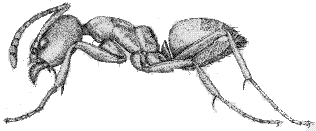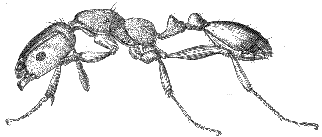IPM for Ants in Schools
Identifying Ants
Since ant species can differ widely in their food requirements, it is important to identify the species before choosing a bait. Like all insects, ant bodies are divided into three segments: head, thorax, and abdomen. Unlike many other insects, however, ants possess a constriction between the thorax and abdomen resulting in a pinched-waste appearance. The constricted part of the abdomen is called the pedicel, and the wider, main part of the abdomen is called the gaster. An important identification characteristic is the number of segments or "nodes" in the pedicel (see the drawings below). For example, one-node ants include the Argentine ant and odorous house ant. Two-node ants include the Pharaoh ant, pavement ant, and little black ant. Final identification is made from size, color, other body characteristics, habits, or other information. Common House-Invading Ant Species provides more information to help you identify your problem ant.

Argentine ant, Linepithema humile

Pharaoh ant, Monomorium pharaonis
The University of Florida offers a poster that combines line drawings, color and scanning electron microscope photographs in an identification key to help individuals identify the most common structure-invading ants.
Tips For Controlling Specific Ants
Argentine Ant - Since it is difficult to eradicate the colony/colonies, efforts should be made to prevent invasion. The Argentine ant will feed on a wide range of foods, and it is particularly important to inspect outdoor plants for the presence of insects that produce honeydew such as aphids and scales. Outside, this ant nests under rocks and logs or in shallow holes in the ground, and it frequently moves its nest to escape unfavorable environmental conditions. Indoors it nests in wall voids, potted plants, under loose tiles, behind baseboards, etc., usually close to moisture sources. Argentine ants enter buildings searching for food or water (especially when it is dry outside), but they may also come indoors to escape wet conditions outdoors. For control, use commercial bait stations along ant trails and around building perimeters.
Pavement Ant - Start inspections at the ground floor or sub-floor level because the pavement ant often originates outdoors at ground level. Follow trails of ants to locate colony/colonies. Outside, trails are usually hidden by grass or mulch next to the building foundation or the edges of pavement. Inside, you can often find trails under edges of carpets along the tack strip. Pavement ants utilize electrical wires, conduit, and water pipes as highways throughout the building. Performing an inspection at night around 10 or 11 PM can be useful since pavement ants are most active at night. Outside, piles of soil near slabs and concrete are a good indication of underground galleries. Effective pavement ant control requires caulking cracks and crevices and placing baits in the path of ant trails near colonies. If pavement ants are not feeding on the bait change to a bait formulation with a different food base (i.e. sugar to protein). Baiting is a slow process that will take several days or longer for satisfactory treatment and may not always eliminate the problem.
Pharaoh Ant - This is a tropical ant that prefers inaccessible dark, humid, and warm habitats. Workers are attracted to baits that contain protein, peanut butter oil, liquid sugars, and granulated silkworm pupae. Place the baits in door or window frames, light switches, and fuse boxes; at floor level in corners and along baseboards; near toilets, sinks, drains, heating pipes, and radiators; and in food cupboards. In warmer areas of the U.S., pharaoh ants often nest indoors and forage outdoors. If foragers are identified outside, place baits in areas of high activity. Use enough bait stations so that feeding will not deplete the bait before the colonies are dead. It may also be advantageous to use baits that combine two different attractants or use several different bait formulations at once.
